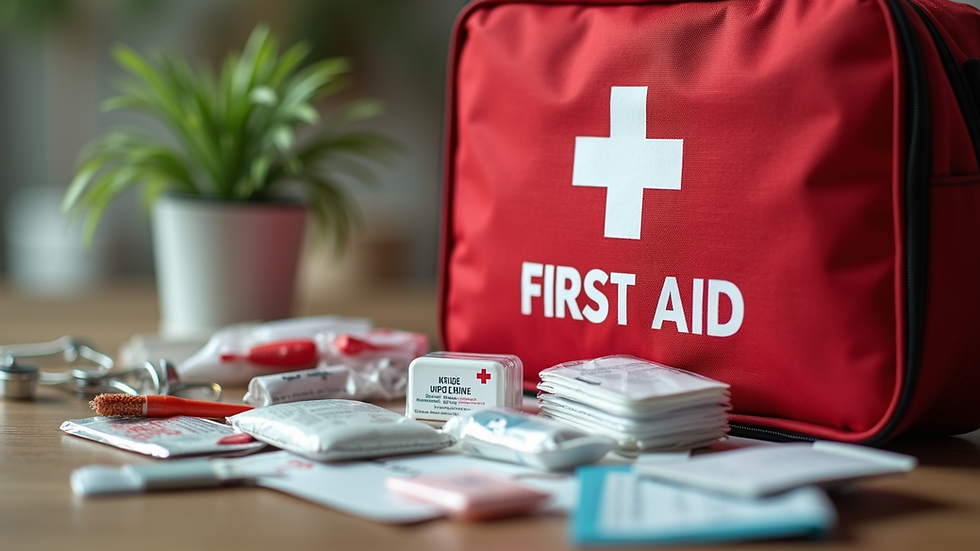Essential Supplies Every First Aid Kit Should Contain
- Aryeh Goldberg

- Aug 18
- 3 min read
When it comes to safety, having a well-stocked first aid kit is crucial. Whether at home, in the car, or at work, a first aid kit can make a significant difference in managing minor injuries and stabilising more serious conditions until professional help arrives. Knowing what to include in your kit ensures you are prepared for common emergencies and can provide effective care when needed.
Building a Comprehensive First Aid Kit
A good first aid kit should be tailored to your environment and the types of injuries you might encounter. However, some basic supplies are essential for every kit. These items help you treat cuts, burns, sprains, and other common injuries quickly and efficiently.
Basic Supplies to Include
Adhesive bandages in various sizes for small cuts and blisters.
Sterile gauze pads to cover larger wounds and control bleeding.
Adhesive tape to secure dressings and bandages.
Antiseptic wipes or solution to clean wounds and prevent infection.
Sterile gloves to protect yourself and others from contamination.
Scissors and tweezers for cutting tape or removing splinters.
Elastic bandages for sprains and strains.
Pain relief medication such as paracetamol or ibuprofen.
CPR face shield or mask for safe resuscitation.
Thermometer to check for fever.
Burn cream or gel to soothe minor burns.
These items form the foundation of any first aid kit and are vital for addressing a wide range of injuries.

Additional Items for Specific Needs
Depending on your lifestyle or workplace, you might want to add:
Allergy medication like antihistamines or an epinephrine auto-injector.
Eye wash solution for flushing out irritants.
Cold packs to reduce swelling.
Finger splints for immobilising injured digits.
First aid manual for quick reference during emergencies.
Customising your kit ensures you are ready for the unique challenges you might face.
Why Your First Aid Kit Matters
Having a first aid kit nearby can save valuable time during an emergency. Immediate care can reduce the severity of injuries and prevent complications. For example, cleaning a wound promptly with antiseptic wipes and covering it with a sterile dressing can prevent infection and promote faster healing.
Moreover, workplaces and public spaces are often required by law to have adequate first aid provisions. Ensuring your kit is compliant with these regulations not only protects individuals but also helps avoid legal issues.
For those interested in professional guidance on first aid provisions, this resource offers comprehensive information on maintaining proper first aid standards.

What are the 7 principles of first aid?
Understanding the core principles of first aid helps you respond effectively in emergencies. These principles guide your actions to provide the best care possible:
Preserve life - Your primary goal is to keep the injured person alive.
Prevent further injury - Avoid causing additional harm by moving the person only if necessary.
Protect the unconscious - Ensure the airway is clear and the person is breathing.
Promote recovery - Provide comfort and reassurance to the injured individual.
Provide pain relief - Use appropriate methods to reduce pain without causing harm.
Prevent infection - Clean wounds and use sterile materials to avoid contamination.
Seek medical help - Call emergency services or get professional medical assistance as soon as possible.
By following these principles, you can deliver effective first aid that stabilises the situation until expert care is available.
Maintaining and Updating Your First Aid Kit
A first aid kit is only useful if it is well-maintained. Regularly check your supplies to ensure nothing is expired or damaged. Replace used or outdated items promptly. Keep the kit in a clean, dry, and easily accessible location known to all household members or employees.
Label your kit clearly and consider including a checklist inside to track inventory. This practice helps you stay prepared and confident in your ability to handle emergencies.

Practical Tips for Using Your First Aid Kit
Stay calm and assess the situation before acting.
Wear gloves to protect yourself and the injured person.
Clean wounds gently with antiseptic wipes before applying dressings.
Apply pressure to stop bleeding using sterile gauze.
Immobilise injuries with elastic bandages or splints.
Use pain relief medication only as directed and if appropriate.
Call emergency services if the injury is severe or life-threatening.
Remember, your first aid kit is a tool to help you provide immediate care. Training in first aid techniques enhances your ability to use these supplies effectively.
By assembling a well-stocked first aid kit and understanding how to use it, you empower yourself to handle emergencies confidently. Whether at home, work, or on the go, being prepared with the right supplies and knowledge can make all the difference in a critical moment. Take the time to review your kit today and ensure you have everything needed to provide prompt and effective care.





Comments